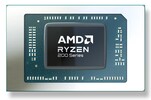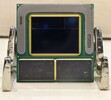AMD Ryzen 7 250 vs Intel Core Ultra 5 236V
AMD Ryzen 7 250
► remove from comparison
The AMD Ryzen 7 250 is a powerful laptop processor (APU) of the now years-old Hawk Point family that was announced at CES 2025. This isn't an entirely new APU; instead, the R7 250 is a rebadged R7 8840U. Its eight Zen 4 cores run at 3.3 GHz to 5.1 GHz and are SMT-enabled for a total of 16 processing threads. The Radeon 780M iGPU is responsible for 3D processing and similar duties.
Architecture and Features
Hawk Point family chips are powered by the Zen 4 architecture, much like Phoenix and Dragon Range family chips were. The 16 TOPS NPU present here isn't powerful enough for systems built around the 7 250 to be Copilot+ certified.
Elsewhere, the chip has 16 MB of L3 cache and support for super-fast DDR5-5600 and LPDDR5x-7500 RAM while also being compatible with USB 4 and thus with Thunderbolt. It comes with 20 PCIe 4 lanes, giving fast NVMe SSD up to 7.8 GB/s of throughput.
Please note that this processor is not overclockable and neither is it user-replaceable. It gets soldered to the motherboard for good instead (FP8 socket interface).
Performance
Since the R7 250 is an 8840U / 7840U in disguise, it's safe to expect it to be about as fast as the Intel Core Ultra 7 256V in multi-thread workloads. Therefore, the CPU performance is good enough even for demanding tasks, as of 2025.
Your mileage may vary depending on how high the CPU power limits are and how competent the cooling solution of your system is.
Graphics
The Radeon 780M has 12 CUs (768 shaders) purring away at up to 2,700 MHz. The Radeon will let you use up to 4 monitors with resolutions as high as SUHD 4320p and it will also HW-decode and HW-encode the most widely used video codecs (such as AV1, HEVC and AVC) without breaking a sweat. As for gaming, most 2024 games run fine at 1080p with settings set to Low on this graphics adapter.
Your mileage may vary depending on how high the CPU power limits are, how competent the cooling solution of your system is, how fast the RAM of your system is (there is no dedicated VRAM here).
Power consumption
This Ryzen 7 series chip has a long-term power limit (default TDP) of 28 W. Laptop makers are free to change that value significantly, with values as low as 15 W and as high as 30 W greenlighted by AMD. Either way, an active cooling solution is a must for any system powered by this chip.
The R7 250 is built with TSMC's 4 nm process for high, as of late 2023, energy efficiency.
Intel Core Ultra 5 236V
► remove from comparison
The Intel Core Ultra 5 236V is a mid-range Lunar Lake family processor. This is an SoC for use in tablets and laptops of the slimmer kind that was unveiled in Autumn 2024. It features 4 new Skymont E-cores and 4 new Lion Cove P-cores running at up to 3.5 GHz and 4.7 GHz respectively, along with the new Arc 130V iGPU and 16 GB of on-package LPDDR5x-8533 RAM. A new 40 TOPS neural engine, Thunderbolt 4 and PCIe 5 SSD support are included as well. A vPro-enabled version of the CPU became available in early 2025.
The only difference between this chip and the Ultra 5 238V is the amount of on-package, non-upgradeable RAM: 16 GB vs 32 GB respectively.
Architecture and Features
Lunar Lake is built using the Foveros technology (stacking several dies on top of each other and next to each other), just like Meteor Lake was. The new chips make use of the enormous BGA2833 socket interface. Of the 8 cores, not a single one is Hyper-Threading-enabled which is the opposite of what AMD currently does with its Zen 5/5c chips.
Intel claims Lion Cove cores bring a 14% IPC improvement over Redwood Cove. For Skymont and Crestmont, the difference is much higher at 68%. Several tweaks and improvements are present here, such as the Low Latency Fabric that is supposed to make small data transfers between cores/caches a lot faster. The 236V's level 3 cache is pretty small as compared to more expensive Ultra 7 2xxV and Ultra 9 2xxV chips at 8 MB vs 12 MB. Elsewhere, the 236V has 4 PCIe 5 and 4 PCIe 4 lanes for connecting various kinds of devices, including NVMe SSDs at up to 15.75 GB/s. Thunderbolt 4 support is onboard by default, as is support for CNVi WiFi 7 + BT 5.4 cards from Intel. The 40 TOPS "AI Boost" neural engine is present along with technologies such as Threat Detection to make AI-enabled applications such as the Windows Defender more powerful.
Intel is predicted to get short of on-package RAM in subsequent CPU generations.
Performance
Based on Geekbench 6.3 Multi test results available online in early Nov 2024, the 236V (and the 238V) delivers around 10,100 points, putting it on equal footing with chips such as AMD's Ryzen 7 7735HS and Apple's M2 which is an OK result for a thin-and-light laptop in late 2024.
Generally speaking, the 226V, 228V, 236V and 238V are slower than the 256V, 258V, 266V, 268V, 288V due to the difference in their last-level cache size (8 MB vs 12 MB) as well as clock speeds. However, the difference in performance between the slowest Lunar Lake chip, the 226V, and the fastest chip, the 288V is fairly small at around 10% to 15%. It depends on the TDP figures of the laptops being pitted against each other more than on anything else.
Graphics
The Arc Graphics 130V has 7 Xe² architecture "cores" running at up to 1,850 MHz, as well as 7 ray tracing units at its disposal. This is a direct successor to the Arc 7 iGPU; it is DirectX 12 Ultimate-enabled and able to HW-decode a long list of video codecs such as h.266 VVC, h.265 HEVC, h.264 AVC, AV1 and VP9. Three SUHD 4320p monitors can be used simultaneously with this iGPU.
Its performance can be vastly different depending on which benchmarks and games one runs. Oftentimes, it isn't much faster than its direct predecessor, the Arc 7. It is clear the 130V isn't fast enough to run most triple-A 2024 games at 1080p. However, it's still more than good enough for an occasional gaming session.
- Helldivers 2: 25 fps (Med, 1080p). The Arc 7 and the Radeon 880M deliver similar results.
- Ready or Not: 40 fps (Med, 1080p). The GeForce MX350 delivers a similar result.
Power consumption
This 2nd generation Core Ultra processor is supposed to consume 17 W when under long-term workloads. The Intel-recommended short-term power limit for the chip sits at 37 W.
| Model | AMD Ryzen 7 250 | Intel Core Ultra 5 236V | ||||||||||||||||||||||||||||||||||||||||||||||||||||||||||||||||
| Codename | Hawk Point-U (Zen 4) | Lunar Lake | ||||||||||||||||||||||||||||||||||||||||||||||||||||||||||||||||
| Series | AMD Hawk Point (Zen 4/4c) | Intel Lunar Lake | ||||||||||||||||||||||||||||||||||||||||||||||||||||||||||||||||
| Series: Lunar Lake Lunar Lake |
|
| ||||||||||||||||||||||||||||||||||||||||||||||||||||||||||||||||
| Clock | 3300 - 5100 MHz | 2100 - 4700 MHz | ||||||||||||||||||||||||||||||||||||||||||||||||||||||||||||||||
| L1 Cache | 512 KB | 1.4 MB | ||||||||||||||||||||||||||||||||||||||||||||||||||||||||||||||||
| L2 Cache | 8 MB | 14 MB | ||||||||||||||||||||||||||||||||||||||||||||||||||||||||||||||||
| L3 Cache | 16 MB | 8 MB | ||||||||||||||||||||||||||||||||||||||||||||||||||||||||||||||||
| Cores / Threads | 8 / 16 8 x 5.1 GHz AMD Zen 4 | 8 / 8 4 x 4.7 GHz Intel Lion Cove P-core 4 x 3.5 GHz Intel Skymont E-core | ||||||||||||||||||||||||||||||||||||||||||||||||||||||||||||||||
| TDP | 28 Watt | 17 Watt | ||||||||||||||||||||||||||||||||||||||||||||||||||||||||||||||||
| Technology | 4 nm | 3 nm | ||||||||||||||||||||||||||||||||||||||||||||||||||||||||||||||||
| Die Size | 178 mm2 | |||||||||||||||||||||||||||||||||||||||||||||||||||||||||||||||||
| max. Temp. | 100 °C | 100 °C | ||||||||||||||||||||||||||||||||||||||||||||||||||||||||||||||||
| Socket | FP8 | BGA2833 | ||||||||||||||||||||||||||||||||||||||||||||||||||||||||||||||||
| Features | DDR5-5600/LPDDR5x-7500 RAM, PCIe 4, USB 4, Ryzen AI (16 TOPS), AES, AVX, AVX2, AVX512, FMA3, MMX (+), SHA, SSE, SSE2, SSE3, SSE4.1, SSE4.2, SSE4A, SSSE3 | LPDDR5x-8533 RAM, PCIe 5 + PCIe 4, USB 4, AI Boost NPU (40 TOPS), Thread Director, PSE, Threat Detection, MMX, SSE, SSE2, SSE3, SSSE3, SSE4.1, SSE4.2, AES, AVX, AVX2, AVX-VNNi, FMA3, SHA | ||||||||||||||||||||||||||||||||||||||||||||||||||||||||||||||||
| iGPU | AMD Radeon 780M ( - 2700 MHz) | Intel Arc Graphics 130V ( - 1850 MHz) | ||||||||||||||||||||||||||||||||||||||||||||||||||||||||||||||||
| Architecture | x86 | x86 | ||||||||||||||||||||||||||||||||||||||||||||||||||||||||||||||||
| Announced | ||||||||||||||||||||||||||||||||||||||||||||||||||||||||||||||||||
| Manufacturer | www.amd.com | ark.intel.com | ||||||||||||||||||||||||||||||||||||||||||||||||||||||||||||||||
| TDP Turbo PL2 | 37 Watt |
Benchmarks
Average Benchmarks AMD Ryzen 7 250 → 100% n=2
Average Benchmarks Intel Core Ultra 5 236V → 98% n=2
* Smaller numbers mean a higher performance
1 This benchmark is not used for the average calculation













